
94% of researchers rate our articles as excellent or good
Learn more about the work of our research integrity team to safeguard the quality of each article we publish.
Find out more
ORIGINAL RESEARCH article
Front. Earth Sci., 16 June 2021
Sec. Sedimentology, Stratigraphy and Diagenesis
Volume 9 - 2021 | https://doi.org/10.3389/feart.2021.663401
This article is part of the Research TopicAdvances in Geology of Unconventional Hydrocarbon ResourcesView all 17 articles
The Mesozoic volcanic rocks are widely developed in the Bohai Bay basin. The D oilfield, located in the southeast of the Bohai Bay Basin, is a Cenozoic depression developed on the base of the Mesozoic. The types of the volcanic rocks are complex and the reservoir space is diverse. According to the characteristics of the volcanic reservoir, such as vertical multi-stage and strong heterogeneity, and based on the analysis of the volcanic core observation, thin section identification, logging data and seismic data, we analyzed the reservoir space type, physical property characteristics and reservoir physical property control factors of volcanic reservoir in the study area. The results show that the volcanic rocks in the study area are mainly volcanic breccia, andesite and tuff; the lithofacies types mainly include volcanic eruption facies, effusion facies and volcanic sedimentary facies, and the volcanic eruption facies is the most developed. Four types of volcanic reservoirs and 14 effective storage space types have been identified from the macroscopic and microscopic multi-scale, mainly intergranular pores, intergranular dissolution pores, intracrystalline pores, structural fractures and weathering dissolution fractures. Reservoir performance is mainly affected by lithology, lithofacies, tectonic activity and diagenesis. The primary pores in the upper part of exhalative and explosive facies are the most developed. Early cement filling is beneficial to the preservation of primary intergranular pore space and is an important prerequisite for the formation of secondary dissolution pores. Under the action of multi-stage tectonic movement and weathering leaching, the reservoir performance of volcanic rocks has been greatly improved, and the volcanic rocks with superimposed fractures and porosities are effective volcanic reservoirs.
In the middle and late last century, the comprehensive geology of volcanic oil and gas reservoirs began to be studied. The main research methods of volcanic reservoir include core analysis, logging analysis, geophysical experiment and so on (Fang et al., 2011; Zhang, 2011; Xiong et al., 2012). The reservoir space of volcanic rocks is more complex than that of sedimentary rocks, and the study of reservoir performance is an important part of volcanic reservoirs (Somasundaram et al., 2017; Leng et al., 2020). According to pore genesis, volcanic reservoir space can be divided into four types: primary pore, secondary pore, primary fracture and secondary fracture, and can be divided into three types: pore, cave and fracture (Hawlander, 1990; Fan et al., 2018; Yu, 2019). The combination of different types of reservoir space leads to the diversity of igneous reservoir space (Jansa, 1988; He et al., 2019; Kong, 2020; Xie, 2020). Among them, fractures play the main role of connectivity and seepage in volcanic reservoir space, which is the focus of reservoir space research. The methods used to identify fractures include conventional logging curve identification method, fracture index method, curvature change rate method, saturation ratio method, discriminant analysis method, fuzzy mathematics method, neural network method, MFI imaging logging method and so on (Wang et al., 2007; Liu et al., 2008; Zhang, 2012). Diagenesis plays a very important role in the evolution of volcanic pores and is an important factor in the development of primary and secondary pores in volcanic reservoirs (Levin, 1995; Liu Y. et al., 2018; Liyao et al., 2018; Hu et al., 2020). The Mesozoic volcanic rocks are widely distributed in the Bohai Bay Basin, covering the whole basin (Jin et al., 2012; Cai et al., 2018; Liu X.J. et al., 2018). In 2014, a high abundance reservoir was found in the Mesozoic of the D oilfield in the South gentle slope of the Laizhouwan sag (Jin et al., 2013; Yang et al., 2017; Wang B. Q. et al., 2020). However, in the research and exploration of volcanic rocks in the Bohai Bay oilfield for many years, due to the high exploration cost of offshore platform, limited data collection, difficult identification of volcanic lithofacies, complex lithology and strong reservoir heterogeneity, the degree of exploration is restricted. Therefore, it is urgent to study the types of reservoir space, porosity and permeability characteristics, pore structure and main controlling factors of the Mesozoic volcanic reservoir, so as to provide certain basis and guidance for later exploration and development as well as favorable area selection. This work can provide ideas for volcanic reservoir prediction and oil and gas reservoir exploration in the Bohai Bay Basin, and provide supplementary for research results of Mesozoic volcanic rocks in offshore oilfields of China, and also has certain reference value for exploration of similar reservoirs.
The Laizhouwan sag is located in the southeast of the Bohai Sea. It is adjacent to the north sag of the Laizhouwan sag in the north and the south sub sag of the Laizhouwan sag in the East. It is a Cenozoic sag developed on the Mesozoic base. Under the influence of the Indosinian movement and the Yanshanian movement, strong volcanic activities occurred in the Mesozoic rifting process (Cai et al., 2001; Duan et al., 2020a). D oilfield is located in the southern slope zone of the Laizhou Bay (Figure 1), and its structure is a fault semi anticline. Due to the complexity of fault development, the oilfield has the characteristics of multiple fault blocks and multiple highs. Its strike is mainly east-west and its dip is due north. The strata revealed by drilling in the study area are the Quaternary Pingyuan formation, Neogene Minghuazhen Formation and Guantao formation, Paleogene Dongying Formation and Shahejie Formation and Mesozoic (not penetrated) from top to bottom (Lu et al., 2018; Wang et al., 2019). The Mesozoic buried hill in the study area is located in the high part, close to the hydrocarbon generation center of the Laizhouwan sag, with good trap conditions, well-developed fractures and good reservoir forming conditions of volcanic rocks. Drilling revealed that the Mesozoic in this area mainly developed volcanic strata of the Cretaceous Yixian formation.
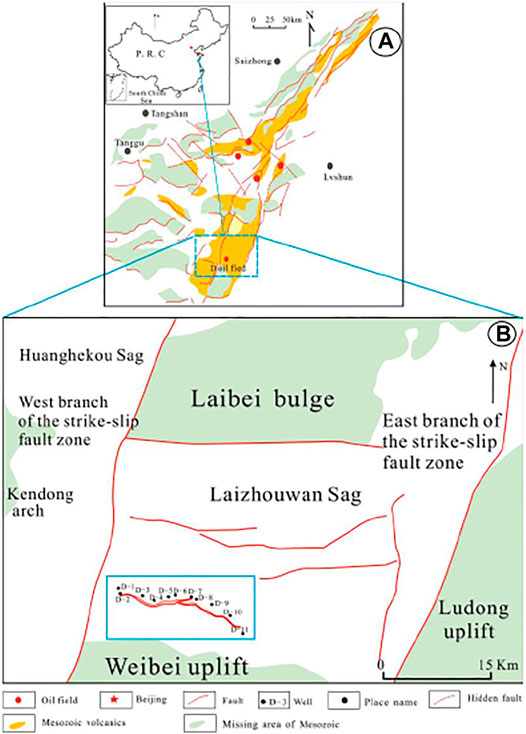
FIGURE 1. Distribution and structural location of main oil and gas fields in the Kenli area. (A) is the Laizhouwan sag location map. (B) is the D oilfield location map. (C) is the D oilfield well location map. using CorelDRAW 2018 (https://www.corel.com/).
Based on the analysis of drilling data and seismic data, the Mesozoic, the target interval of this study, is revealed by drilling of D-4, D-6, D-7, D-9, and D-10 within the scope of the oilfield (Figure 2C). However, the drilling did not drill through the formation, and the thickness of the revealed formation is 11.8–215.0 m. The lithology of the study area mainly includes pyroclastic rock, lava and sedimentary pyroclastic rock (Duan et al., 2020b). This area belongs to low exploration area and has great exploration potential.
We have collected eight logging curves from each well in the core bank of the D oilfield. Reservoir evaluation method requires qualitative analysis of sedimentation and diagenesis, and quantitative analysis of physical properties and pore structure. A total of 68 core samples were processed by scanning electron microscope (Evo) to identify clay mineral distribution and secondary pore size. In order to identify the clay minerals in volcanic rocks, X-ray diffraction analysis of clay with size less than 2 μm was carried out in Rigaku RU 200 diffractometer. The sample used for diffractometer was air dried, ethylene glycol was saturated and heated at 490°C for 4 h. According to the Darcy’s law, a total of 123 samples were collected from the target reservoir for conventional petrophysical analysis, and gas porosity and permeability were measured by instruments. We identified 136 samples from the study area by conventional rock and mineral methods by polarizing microscope (POROTm300). In addition, a total of 78 samples were made into thin cast sheets, and the samples were vacuum impregnated with alizarin epoxy resin and potassium ferricyanide, so that the pores could be clearly seen and the carbonates could be identified (Dickson, 1965). The Dickson’s method helps to distinguish between pores and grains. Put the full diameter core into GE vtomx m 300 nm CT equipment, adjust the equipment parameters for scanning, and get pore data table, pore throat data table and scanning slice.
Based on the analysis of cuttings, logging data, core thin section data and borehole wall coring data of each well in the study area, the main types of Mesozoic volcanic rocks in the study area are pyroclastic rocks, volcanic lava and sedimentary pyroclastic rocks. A small amount of pyroclastic sedimentary rocks, mainly tuffaceous glutenite, can be seen in the lower part of D-7 and D-10.
Pyroclastic rocks include volcanic breccia, tuff, tuffaceous volcanic breccia, volcanic breccia tuff, and breccia bearing rhyolitic tuff. The Volcanic lava can be seen andesite, rhyolite, dacite. The tuff is mostly light gray, light brown and gray, mainly composed of fine volcanic ash and volcanic dust, containing a small amount of quartz, hornblende and biotite, with massive structure and tuff structure, dense and hard, and some of them are altered. The Volcanic breccia is mainly gray, grayish green and reddish brown. The gravel is mainly composed of volcanic rock block and feldspar. The rock debris is mainly andesite and rhyolite. The crystal debris is mainly composed of neutral plagioclase and subangular. The separation is poor, with fracture development and volcanic breccia structure. The Volcanic breccia tuff is mainly grayish green and variegated. Its rock composition is mainly composed of volcanic breccia, cuttings and tuffaceous. The Volcanic breccia is rhyolite and tuff, and crystal cuttings are quartz and feldspar. The rock pores are not developed. The main reservoir space is microcracks or dissolution pores, and most of them are tuff structure. The andesite is mainly brownish gray and dark brown, with porphyritic texture. The phenocrysts are feldspar and plagioclase, and the matrix is fine lath plagioclase, showing interwoven structure. The development of rock pores is poor, with fracture development, a small amount of chlorite and argillaceous filling, and a small amount of phenocryst corrosion pores. The tuff is mainly variegated, and the rock is mainly composed of cuttings and volcanic dust. The cuttings are mainly quartz and feldspar of medium and fine sand grade. Most of the cuttings are altered, and some of them are argillized. The matrix is mainly siliceous formed by volcanic dust under high temperature and high pressure, evenly distributed among rock cuttings, with medium development of fractures and pores and tuff structure (Figure 2).
Among the volcanic rocks in the study area, the content of pyroclastic rocks is the highest, followed by sedimentary pyroclastic rocks. Among the pyroclastic rocks, the content of volcanic breccia is the highest, followed by tuffaceous volcanic breccia. Among the volcanic lava, andesite has the highest content. Among the sedimentary pyroclastic rocks, the content of tuff is the highest. Other lithology is mainly mudstone, dolomite and a small amount of mixed rock (Figure 3).
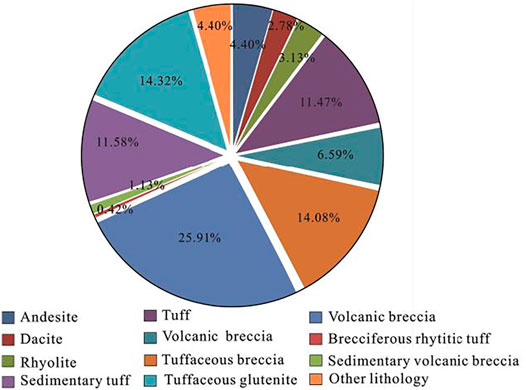
FIGURE 3. Lithologic content ratio of the Mesozoic volcanic rocks in the D oilfield of the Laizhouwan sag.
On the basis of lithology identification of the Mesozoic D oilfield in the Laizhouwan sag, combined with volcanic eruption characteristics (Cas and Wright, 1987), volcanic rock types, production morphology and core thin section characteristics of the Bohai Bay Basin, it is divided that the main development of Mesozoic strata is explosive facies accounting for 61.8%, overflow facies accounting for 10.09% and volcanic sedimentary facies accounting for 28.11% (Table 1).
It can be seen from the lithofacies model of the Mesozoic volcanic rocks (Figure 4) that the study area is mainly composed of eruptive facies and effusive facies. Vertically, it is mainly a volcanic cycle. From bottom to top, the cycle is mainly composed of eruptive facies, exhalative facies and volcanic sedimentary facies, and a few of them are composed of eruptive facies and overflow facies.
According to the data of core, imaging logging and thin section, the Mesozoic reservoir is mainly of pore type, followed by the development of microfractures and dissolution pores, with fracture width of 0.03–0.20 mm and cross connection, forming an effective seepage channel. According to the log interpretation results, the distribution range of reservoir porosity is 2–31.1%, the average value is 14.01%, mainly distributed in 5–20%. The fracture porosity ranges from 0.01 to 1.52%, which shows the reservoir characteristics of high porosity and dual porosity medium. The permeability distribution ranges from 0.003 to 79.3 mD, with a large span, which is mainly caused by the complex lithology. The overall lithology is relatively dense, and the permeability is small, with an average permeability of 6.16 mD (Figure 5).
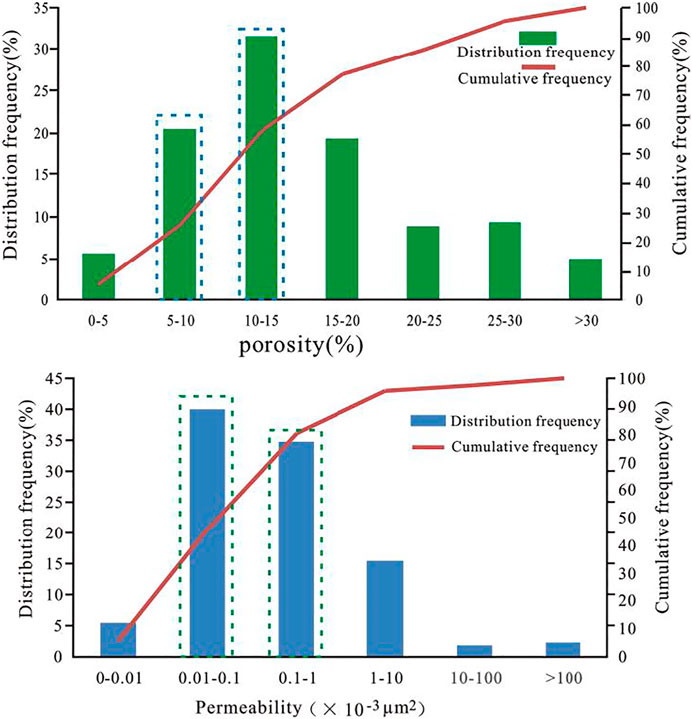
FIGURE 5. Distribution frequency of porosity and permeability of the Mesozoic volcanic rocks in the D oilfield of the Laizhouwan sag.
From the relationship between permeability and buried depth, it can be seen that the permeability decreases with the increase of depth. It can be seen from the relationship between porosity and permeability (Figure 6) that the correlation coefficient of porosity and permeability is only 0.1067, which is poor. Therefore, fractures have a certain impact on the reservoir space and belong to the pore fracture type reservoir.
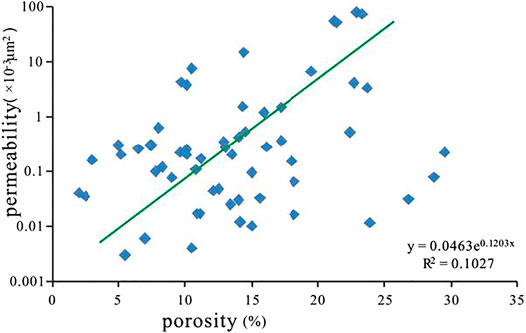
FIGURE 6. Relationship between porosity and permeability of the Mesozoic volcanic rocks in the D oilfield of the Laizhouwan sag.
The volcanic rocks in the study area are affected by tectonism, weathering leaching and diagenesis. The types of reservoir space include primary pore, secondary pore, primary fracture and secondary fracture (Table 2). The Mesozoic reservoir is dominated by pore type, followed by microfractures and dissolution pores, with fracture width of 0.03–0.20 mm and cross connection, forming an effective seepage channel (Figure 7).
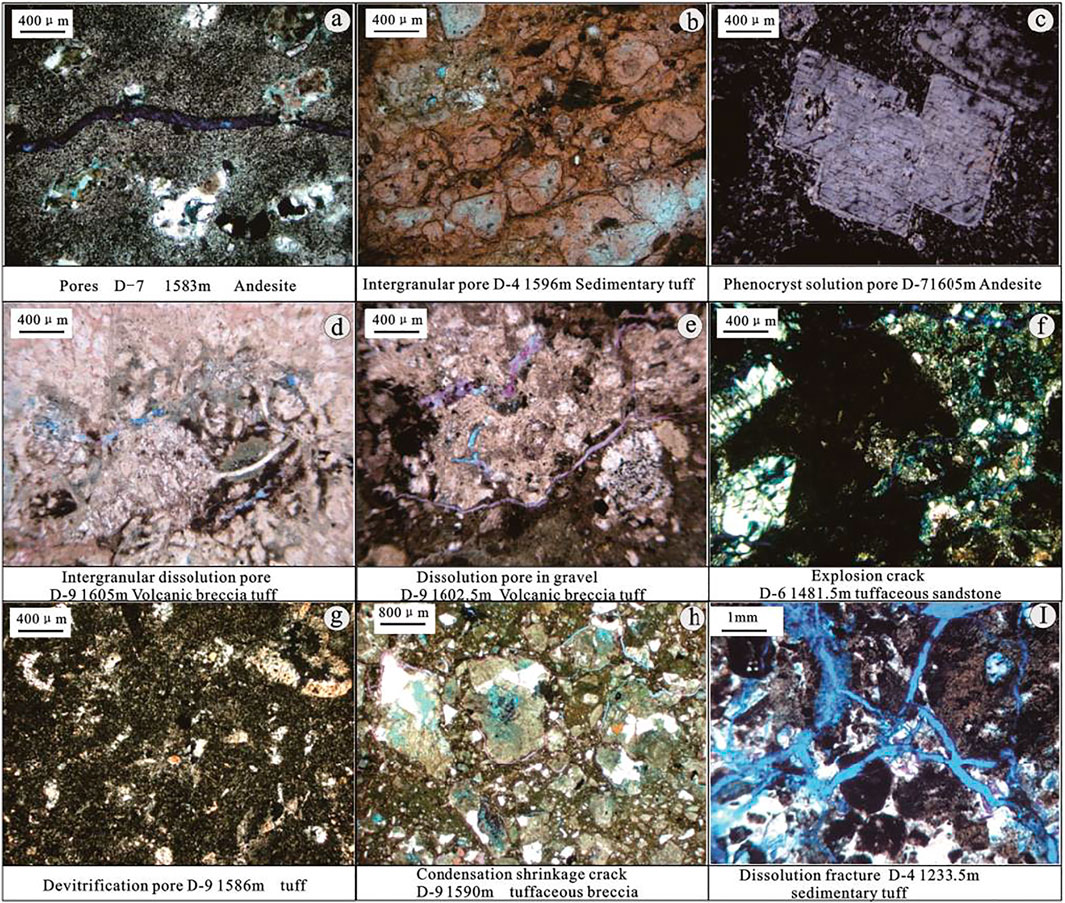
FIGURE 7. Photos of the Mesozoic volcanic reservoir space types in the D oilfield of the Laizhouwan sag.
Through the analysis of capillary pressure curves measured by mercury injection method (Wang M.Q. et al., 2020) in each well in the study area, it can be seen that the pore throat of the reservoir in the study area belongs to the reservoir with good sorting and fine skewness. According to the shape and parameters of capillary pressure curves of different rock samples, the micro pore structure of the reservoir in the study area can be divided into three categories (Figure 8).
Type I pore structure: the displacement pressure of this kind of reservoir is very low, the median pressure value of mercury saturation is low, the maximum mercury saturation value is relatively high, and the curve platform is good. It is the best pore structure of volcanic reservoir in the study area because of the coarseness of pore throat, the best physical property, the largest pore throat radius and the largest average capillary pore radius.
Type II pore structure: the displacement pressure of this kind of reservoir is relatively low, the median pressure of mercury saturation is relatively low, the maximum mercury saturation is relatively high, and the curve has no obvious platform. This kind of reservoir has smaller physical properties, smaller maximum pore throat radius and average capillary radius, which is a relatively good pore structure of volcanic reservoirs in the study area.
Type III pore structure: this kind of reservoir has relatively high displacement pressure, relatively high median pressure of mercury saturation, low maximum mercury saturation and good curve platform. This kind of reservoir has the worst physical property, the average value of maximum pore throat radius and capillary pore radius is the smallest, and the displacement pressure is the highest, which is the relatively poor pore structure of volcanic reservoir in the study area.
According to the statistics of the fractures identified in the study area, it can be seen that the filled fractures account for 48.32% of the total fractures, nearly half of them, the half-filled fractures account for 32.55%, the unfilled fractures account for 19.12%, and the fracture width is mainly distributed between 0.01 and 0.5 mm. According to the core photos and core description statistics, the low angle fractures of volcanic rocks in the study area are the most developed, accounting for 34.88%, followed by oblique fractures, accounting for 32.56%, and high angle fractures, accounting for 23.26%. The vertical fractures and horizontal fractures were the least developed, accounting for 6.98 and 2.33%, respectively. Low angle fractures and oblique fractures are the main types of fractures in the study area (Figure 9). The fracture strikes in the study area are mainly northeast-southwest, and a small part of the fractures are near east-west. The fracture porosity in the study area was calculated to be 0.2% (Figure 10).
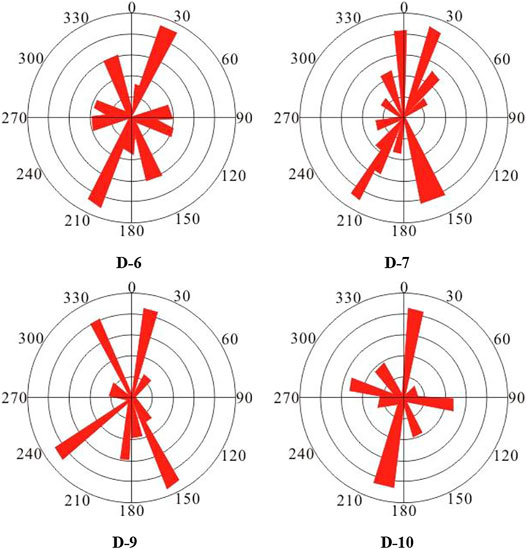
FIGURE 10. Rose diagram of fracture strike of the Mesozoic volcanic rocks in the D oilfield of the Laizhouwan sag.
The evolution of reservoir pore is affected by lithology, diagenesis and tectonism of volcanic rocks, and goes through the whole process of volcanic reservoir formation. During the Mesozoic Jurassic, the Bohai Bay Basin entered the rift basin development stage, accompanied by a large number of volcanic activities. The magma erupted and deposited in the rift basin. After the volatilization and dissipation of gas, a large number of pores are formed in volcanic rocks. At the same time, due to the gradual decrease of temperature, the rock condenses and shrinks to produce condensing contraction joints, which makes the reservoir performance better. In the later stage of magmatism, amygdaloid was formed due to hydrothermal alteration. With the continuous deposition of volcanic rocks, the primary pores decrease due to filling and crystallization. At the same time, with the deepening of burial depth, the porosity will also decrease under the influence of compaction. Under the weathering and leaching process, some previously deposited strata exposed to the surface due to the continuous uplift of the later strata produce secondary pores. Under the dissolution caused by the infiltration of acidic liquid into the reservoir, the porosity is continuously expanded and the reservoir capacity is increased. But at the same time, the porosity will decrease because the fractures and pores are filled by quartz or feldspar again, with the influence of metasomatism and filling. With the continuous progress of tectonic movement, a large number of fractures are produced in the rock after diagenesis due to the late structural fragmentation, which increases the reservoir performance. After the continuous change of pore evolution, the volcanic reservoir pores are finally and stably formed (Figures 11, 12).
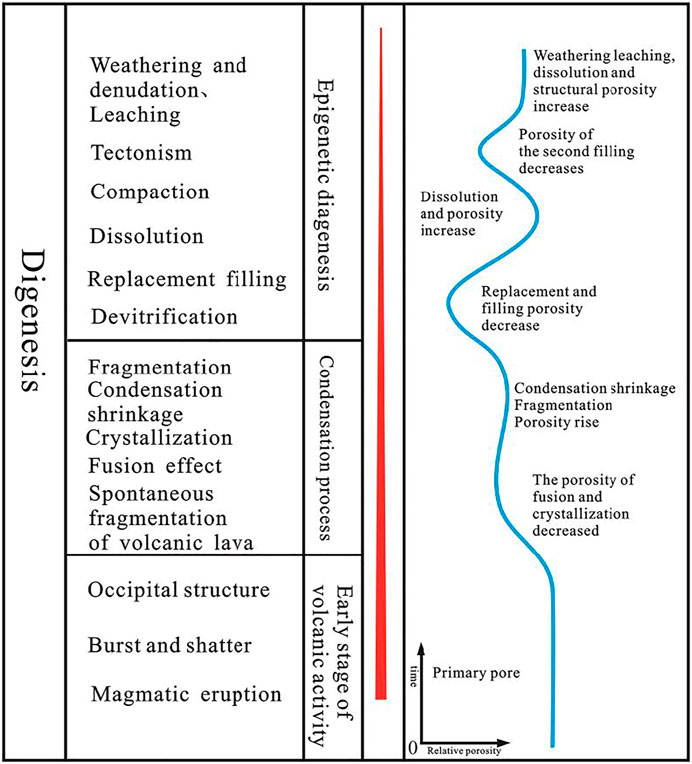
FIGURE 11. Diagenesis and porosity evolution of volcanic reservoir in the D oilfield of the Laizhouwan sag.

FIGURE 12. Diagenesis and porosity evolution of volcanic reservoir in the D oilfield of the Laizhouwan sag.
The formation of volcanic reservoir is complex and the types of reservoir space are various, and its formation process is controlled by many factors (Zhang et al., 2018; Zheng et al., 2018; Yang et al., 2020). Through the study of the Mesozoic volcanic reservoir in the D oilfield of the Laizhouwan sag, it is considered that the reservoir development is mainly affected by lithology, tectonic movement and diagenesis.
Combined with previous studies, we can know that any volcanic rock lithology can form reservoir, but the enrichment degree of volcanic rocks with different lithology is different, which mainly depends on the influence of volcanic eruption intensity, lithofacies, tectonism, and diagenesis on the reservoir space type and development degree of volcanic rocks (Ran et al., 2005; Tang and Ji, 2006; Zhu et al., 2019).
According to the statistical results of physical properties of different lithology, the physical properties of different types of volcanic rocks are obviously different, and the best physical properties are tuff, volcanic breccia and andesite. The porosity of the Tuff is mainly distributed in 7.9–31.1%, and the average porosity is 17.72%. The permeability is mainly distributed in 0.004–79.3 mD, and the average permeability is 14.19 mD. The porosity of volcanic breccia ranges from 2.2 to 30.3%, and the average porosity is 16.185%. The permeability is 0.006–40 mD, and the average permeability is 5.2 mD. The porosity of andesite is mainly distributed in 7.5–16.1%, the average porosity is 14.2%. The permeability is mainly distributed in 0.2–14.9 mD, and the average permeability is 3.5 mD (Figure 13).
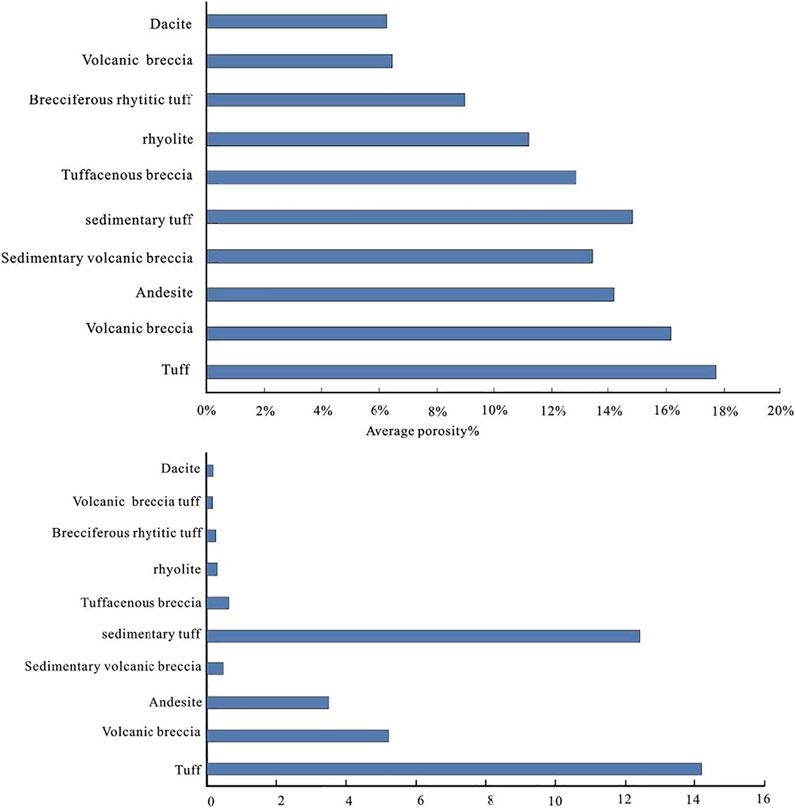
FIGURE 13. Average values of porosity and permeability for different lithology of the Mesozoic in the D Oilfield.
According to the statistics of the face rate of different lithology in the study area (Figure 14), the average face rate of tuff in the study area is the highest, which is 7.29%, followed by volcanic breccia and andesite, which are 5.82 and 4.92%, respectively. The face ratios of volcanic breccia, tuff, tuff and tuffaceous volcanic breccia are 4.12, 4.03, 3.46, and 3.28%, respectively. The dacite and rhyolite have the lowest average face rate of 2.87 and 2.23%, respectively. In general, the best lithology in the study area is tuff, andesite and volcanic breccia.
The tectonic movement controls the volcanic activity and the distribution of volcanic rocks, and improves the performance of volcanic reservoir space. The Tectonic movement can cause a large number of fractures in the originally dense volcanic reservoir, which further improves the original reservoir performance (Su et al., 2020).
In the Bohai Sea area, the Mesozoic volcanic activity occurred in the late Jurassic Early Cretaceous, mainly in the early Cretaceous. The Cretaceous volcanic rocks are mainly developed in the low uplift of the northern Laizhou Bay. The southern section of the Bohai Sea is the most active area of the Mesozoic volcanic activity in the Bohai Sea. The Seismic data show that strike slip and extension fault systems are developed in the gentle slope zone of the southern the Laizhouwan sag. A large fault nose is developed in the basement of the Mesozoic, which is controlled by two first type faults. The degree of rock brittleness affects the formation of fractures. Under the same tectonic stress, the more brittle the rock is, the more likely it is to produce fractures. The Volcanoes with less brittleness are prone to deformation and fractures are not developed. Many primary pores in volcanic rocks are not connected with each other, so the permeability of volcanic rocks is very poor. The Tectonic action can form a large number of fractures, which connect the original isolated primary pores in volcanic rocks and increase the reservoir space of volcanic rocks. Moreover, structural fractures are also an important channel for groundwater and organic acids, which is the key to form secondary dissolution pores and improve the seepage capacity of reservoirs (Deng et al., 2002).
The development degree of structural fractures in the study area is andesite, volcanic breccia tuff, volcanic breccia, sedimentary tuff, rhyolite, dacite, tuff, tuffaceous volcanic breccia, rhyolitic tuff, and sedimentary volcanic breccia (Figure 15).
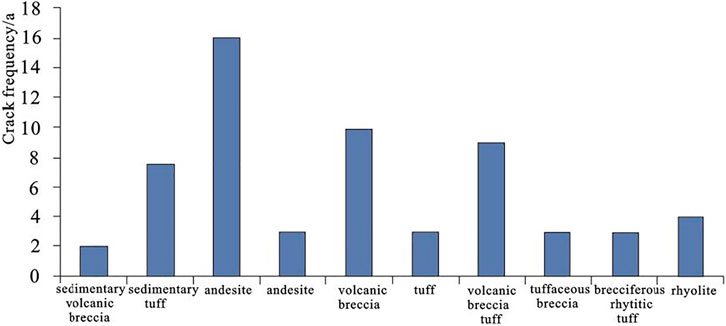
FIGURE 15. Development frequency of structural fractures with different lithology in Mesozoic of D Oilfield.
Diagenesis is one of the important factors affecting the reservoir performance of volcanic rocks (Wang et al., 2017; Miao et al., 2020). In the epidiagenetic stage, the constructive diagenesis is mainly structural fragmentation, weathering leaching and dissolution. In the study area, faults are relatively developed, and groundwater or acidic liquid can penetrate into volcanic reservoir through faults, so as to dissolve the reservoir and improve the reservoir performance. Weathering leaching mainly occurs when the volcanic rocks are exposed to the surface, and the soluble components in the rocks are weathered and dissolved, which improves the reservoir performance. The tectonic process can produce a large number of fractures and connect the originally disconnected pore volume, which greatly improves the reservoir performance. In the stage of burial diagenesis, the main constructive effects on reservoir performance are dissolution and tectonism. At the same time, the mechanical compaction can also improve the reservoir performance to a certain extent, because the mechanical compaction can make the clastic particles in the volcanic rocks break up and improve the reservoir, and the secondary dissolution can make the phenocryst, matrix and various fillers in the pores be dissolved, thus forming secondary pores and improving the reservoir performance. According to the statistics of the distance between the oil producing section and the top of the Mesozoic, the oil layer has a large vertical span, oil-bearing as a whole and local enrichment. However, the vertical enrichment intervals of each fault block are different. The well depth of oil-bearing interval is generally 1,200–1,700 m, and the oil layer is mainly developed within 100 m below the weathering crust at the top of the Mesozoic (Figure 16).
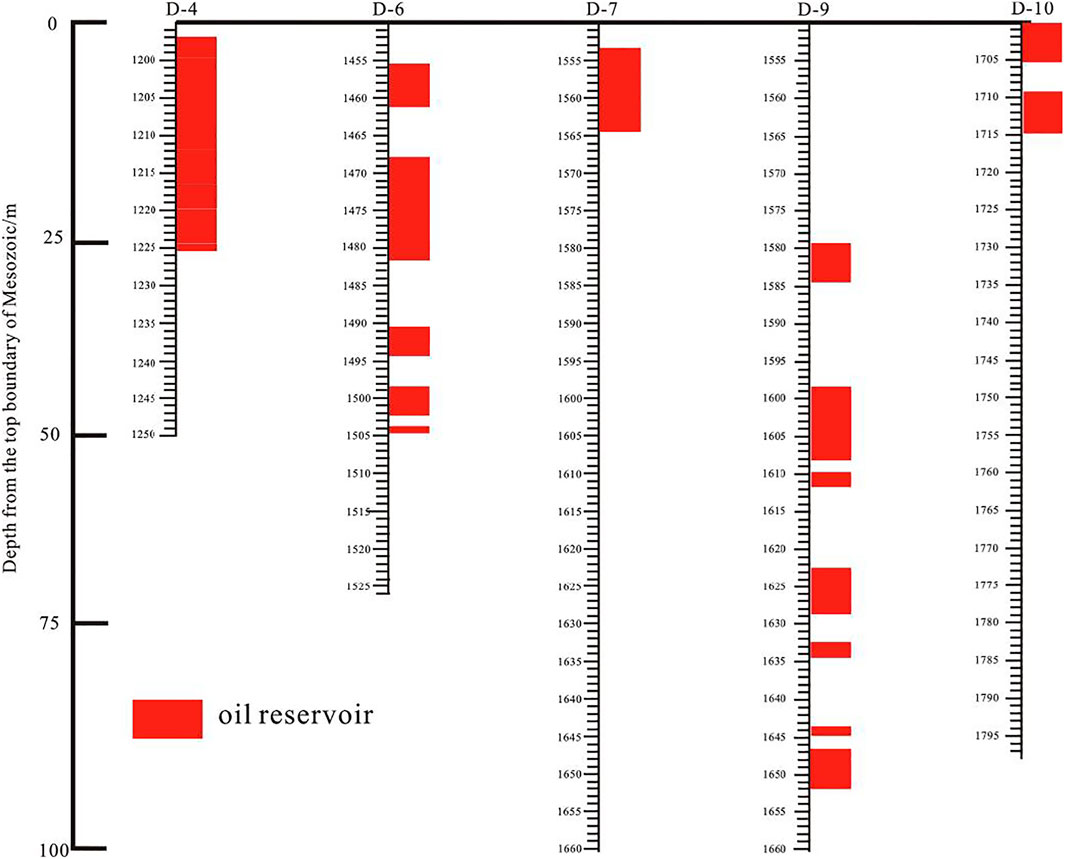
FIGURE 16. The distance between the oil bearing section of oil wells and the top boundary of the Mesozoic in the study area.
In the process of syngenetic magmatic fusion, the crystal chips and glass chips in the rocks are flattened and arranged. The fusion structure of the rocks makes the arrangement more compact and the primary pores smaller. Thermal alteration changes mineral composition and structure and reduces primary reservoir space. In the stage of epigenetic diagenesis, filling and cementation are the main destructive factors. Microcrystalline siliceous aggregate is filled in the breccia, quartz, iron calcite, siliceous, feldspar and other materials are filled in the pores and fractures, making the pores smaller. The chlorite and carbonate minerals produced during cementation also make primary or secondary pores smaller. Filling and compaction are the main destructive factors in burial diagenesis. Compaction can make the clastic particles in volcanic rocks arrange more closely and reduce the primary pores. Generally speaking, the porosity decreases with the increase of burial depth. Because the buried depth of the Mesozoic volcanic rocks in the Laizhouwan sag is relatively shallow, the destructive effect of compaction on reservoir performance is relatively weak. From the relationship between porosity and burial depth (Figure 17), it can be seen that with the increase of burial depth, porosity gradually decreases and reservoir physical properties gradually deteriorate, but the change range is not large. And there will be a relatively high porosity development zone, the porosity gradually decreases from 1,200 to 1,800 m, but the porosity can still reach 27% in 1,580–1,800 m well section. This is because igneous rock is condensed rock, which is less affected by compaction, especially volcanic lava, so the relationship between volcanic rock reservoir and buried depth is small.
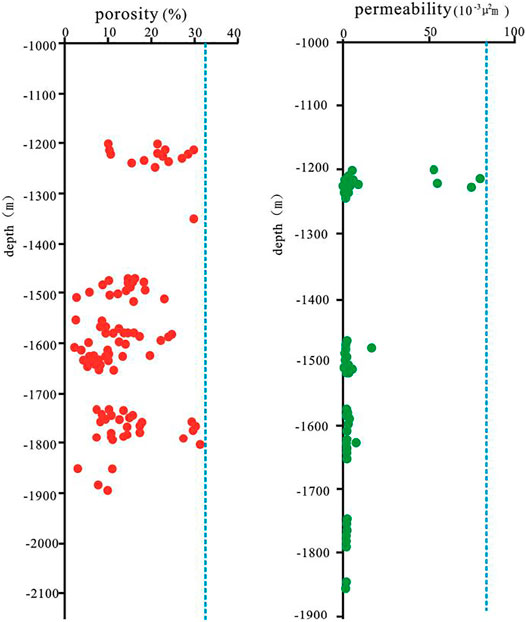
FIGURE 17. Relationship between porosity, permeability and burial depth of Mesozoic volcanic rocks in D oilfield of the Laizhouwan sag.
It can be seen that the lithofacies of volcanic rocks in the study area is the basic factor affecting the reservoir development, weathering leaching and dissolution are the key factors to improve the physical properties of volcanic rocks, and tectonism is an important factor affecting the reservoir performance of volcanic rocks, which controls the development of structural fractures.
(1) According to lithology identification, the study area mainly develops volcanic lava (andesite, dacite, and rhyolite), pyroclastic rock (tuff, volcanic breccia tuff, tuffaceous volcanic breccia, volcanic breccia, and rhyolitic volcanic breccia) and sedimentary pyroclastic rock (sedimentary volcanic breccia, and sedimentary tuff). There are three types of lithofacies: explosive facies, exhalative facies, and volcanic sedimentary facies, among which the most important one is explosive facies. According to logging and seismic data, the lithofacies types and distribution characteristics of volcanic rocks are identified. From the bottom to the top of the study area, there are explosive facies, exhalative facies and volcanic sedimentary facies.
(2) Combined with borehole coring and cast thin section data, the main reservoir space types in the study area are primary pore, secondary pore, primary fracture and secondary fracture. The porosity distribution ranges from 2 to 31.1%, with an average of 14.01%. The permeability distribution ranges from 0.003 to 79.3 mD, and the average permeability is 6.16 mD. The best physical properties are tuff, andesite and volcano breccia. According to the capillary pressure curve, the study area has three types of pore structure.
(3) Through the analysis of the reservoir in the study area, two kinds of diagenesis exist in the study area. The constructive diagenesis mainly includes condensation contraction, tectonism, weathering leaching, devitrification, dissolution, and alteration. The destructive effects include compaction, filling, crystallization, and metasomatism. Reservoir development is mainly affected by lithology, tectonic movement, and diagenesis.
The original contributions presented in the study are included in the article/Supplementary Material, further inquiries can be directed to the corresponding author.
JX and BL contributed to the conception of the study; XH and YD finished the first draft; YS and HL contributed significantly to analysis and manuscript preparation; BL, YD, WC, and RW conducted data preparation and experimental analysis; XH has made a lot of revisions to the paper revision, and through the constructive discussion help to carry on the analysis. All authors reviewed the manuscript.
This work was cofunded by the National Natural Science Foundation of China (Grant Nos.51674156 and 51504143) and the Innovation Team of Shandong University of Science and Technology (2015TDJH101).
The author YS was employed by the company CNOOC China Limited.
The remaining authors declare that the research was conducted in the absence of any commercial or financial relationships that could be construed as a potential conflict of interest.
The authors thank the Bohai Petroleum Research Institute for supplying core samples and logging data. The authors also wish to thank the anonymous reviewers for their careful work and thoughtful suggestions and the editors for their valuable comments.
Cai, D. M., Ye, T., Lu, F. T., Gao, K. S., and Ren, Y. P. (2018). Lithofacies Characteristics and Identification Methods of Mesozoic Volcanic Rocks in Bohai Sea. Lithologic Reservoirs. 30, 112–120. doi:10.3969/j.issn.1673-8926.2018.01.011
Cai, D. S., Luo, Y. H., and Yao, C. H. (2001). Strike-slip and Pull-Apart Structure Study and its Significance to Petroleum Exploration on Laizhouwan Sag, Bohai Area. Acta Petrolei. Sinica. 22 (02), 19–25. doi:10.3321/j.issn:0253-2697.2001.02.004
Cas, R. A. F., and Wright, J. V. (1987). Volcanic Successions, Modern and Ancient: a Geological Approach to Processes, Products, and Successions. Allen&Unwin, 528. doi:10.1007/978-94-009-3167-1
Deng, P., Chen, M. J., and Gao, Z. R. (2002). Log Response and Explanation of Structural Fractures in Volcanic Rock Reservoir. Acta Petrolsi. Sinica. 23 (6), 32–36. doi:10.1007/s11769-002-0037-5
Dickson, J. A. D. (1965). A Modified Staining Technique for Carbonates in Thin Section. Nature 205, 587. doi:10.1038/205587a0
Duan, Y. J., Xie, J., Li, B. C., Wang, M. Q., Zhang, T. Q., and Zhou, Y. W. (2020a). Lithology Identification and Reservoir Characteristics of the Mixed Siliciclastic-Carbonate Rocks of the Lower Third Member of the Shahejie Formation in the South of the Laizhouwan Sag, Bohai Bay Basin, China. Carbonates and Evaporites 35 (2). doi:10.1007/s13146-020-00583-8
Duan, Y., Xie, J., Su, Y., Liang, H., Hu, X., Wang, Q., et al. (2020b). Application of the Decision Tree Method to Lithology Identification of Volcanic Rocks-Taking the Mesozoic in the Laizhouwan Sag as an Example. Sci. Rep. 10 (05), 19209. doi:10.1038/s41598-020-76303-y
Fan, C., Qin, Q., Liang, F., Fan, Z., and Li, Z. (2018). Fractures in Volcanic Reservoir: a Case Study of Zhongguai Uplift in Northwestern Margin of Junggar Basin, China. Earth Sci. Res. J. 22 (3), 169–174. doi:10.15446/esrj.v22n3.75426
Fang, J., Jia, C. Z., Ran, Q. Q., Zhou, X. M., and Hui, G. (2011). The Study of Fracture in Volcanic Reservoir. CPS/SPE International Oil&Gas Conference and Exhibition. Beijing, China: Jilin University. 2000, 8–10. doi:10.2523/131813-MS
Hawlander, H. M. (1990). Digenesis and Reservoir Potential of Volcanogenic Sandstones-Cretaceous of the Surat Basin, Australia. Sediment. Geology. 66 (4), 181–195. doi:10.1016/0037-0738(90)90059-3
He, J., Wang, H., Zhang, C., Yang, X., Shangguan, Y., Zhao, R., et al. (2019). A Comprehensive Analysis of the Sedimentology, Petrography, Diagenesis and Reservoir Quality of Sandstones from the Oligocene Xiaganchaigou (E3) Formation in the Lengdong Area, Qaidam Basin, China. J. Petrol. Explor Prod. Technol. 9 (2), 953–969. doi:10.1007/s13202-018-0571-z
Hu, X., Xie, J., Cai, W. C., Wang, R., and Davarpanah, A. (2020). Thermodynamic Effects of Cycling Carbon Dioxide Injectivity in Shale Reservoirs. J. Pet. Sci. Eng. 195, 107717. doi:10.1016/j.petrol.2020.107717
Jansa, L. F. (1988). Pe-Piper G. Middle Jurassic to Early Cretaceous Igneous Rocks along Eastern North American continental Margin. Aapg Bull. Am. Assoc. Pet. Geologists 72 (3), 347–366. doi:10.1306/703C8C27-1707-11D7-8645000102C1865D
Jin, C., Pan, W., and Qiao, D. (2013). Volcanic Facies and Their Reservoirs Characteristics in Eastern China Basins. J. Earth Sci. 24 (6), 935–946. doi:10.1007/s12583-013-0380-8
Jin, C. S., Qiao, D. W., and Dan, W. N. (2012). Meso-Cenozoic Volcanic Rock Distribution and Reservoir Characteristics in the Bohai Bay Basin. OIL GAS GEOLOGY. 033 (001), 19–29. doi:10.11743/ogg20120103
Kong, C. X., Xiao, Y., Chen, L. C., Jia, J. F., and Zhang, H. Y. (2020). Research on Volcanic Reservoir Prediction in Jinlong. J. Phys. Conf. Ser. 1549 (4). doi:10.1088/1742-6596/1549/4/042027
Leng, Q. L., Huang, Y. L., Ran, B., Zhang, J. M., and Wang, P. J. (2020). Development Characteristics and Controlling Factors of Dissolution Pores in Pyroclastic Reservoirs: A Case Study of the Lower Cretaceous in Lujiapu Sag, Southern Songliao Basin. Glob. Geology. 39 (02), 1–10. doi:10.3969/j.issn.1004-5589.2020.02.011
Levin, L. E. (1995). Volcanogenic and Volcaniclastic Reservoir Rocks in Mesozoic-Cenozoic Island Arcs: Examples from the Caucasus and the Nw Pacific. J. Pet. Geol. 18 (3), 267–288. doi:10.1111/j.1747-5457.1995.tb00906.x
Liu, X. J., W, Q. B., Dai, L. M., and Hao, Y. W. (2018). Relationship between Lithofacies Characteristics and Reservoirs of Mesozoic Volcanic Rocks in Laizhouwan Sag. Pet. Geology. Eng. 032 (003), 1–6. doi:10.3969/j.issn.1673-8217.2018.03.001
Liu, Y., Hu, W., Cao, J., Wang, X., Tang, Q., Wu, H., et al. (2018). Diagenetic Constraints on the Heterogeneity of Tight sandstone Reservoirs: A Case Study on the Upper Triassic Xujiahe Formation in the Sichuan Basin, Southwest China. Mar. Pet. Geology. 92 (92), 650–669. doi:10.1016/j.marpetgeo.2017.11.027
Liu, Z. D., Liu, H. Q., Dai, S. H., Wang, H. L., and Yu, H. G. (2008). Study on Volcanic Rock Fracture Quantitative Identificantion Method Using Logging Data. PGODD 27 (5), 132–134. doi:10.3969/j.issn.1000-3754.2008.05.035
Liyao, L., Jiuchuan, W., and Huiyong, Y. (2018). Influence of Sedimentary Facies on Reservoir Quality and Distribution of Diagenetic Features in the Funing Formation, Wanglongzhuang Oilfield, Subei Basin, Eastern China. Arabian J. Geosciences 11 (15), 432–445. doi:10.1007/s12517-018-3745-6
Lu, C., Liu, Z., Jia, H., Dai, Q., Li, M., Ren, M., et al. (2018). The Controls of Geomorphology and Sediment Supply on Sequence Stratigraphic Architecture and Sediment Partitioning of the Lacustrine Rift basin in the Es3 of Liuzan Area, Nanpu Sag, Bohai Bay Basin, China. Aust. J. Earth Sci. 65, 275–301. doi:10.1080/08120099.2018.1413594
Miao, C. S., Xu, W., Liu, Y. H., and Xie, R. X. (2020). Characteristics of Volcanic Rock Reservoir in Southern Songliao Basin. J. Jilin Univ. (Earth Sci. Edition) 50 (02), 635–643. doi:10.13278/j.cnki.jjuese.20190253
Ran, Q. Q., Hu, Y. L., and Ren, B. S. (2005). A Lithologic Identification Method of Igneous Rocks and its Application:a Case of the Igneous Reservoir in Block Zao-35. China of Fsh Ore Oil and Gas 17 (1), 25–30. doi:10.3969/j.issn.1673-1506.2005.01.006
Somasundaram, S., Mund, B., Soni, R., and Sharda, R. (2017). Seismic Attribute Analysis for Fracture Detection and Porosity Prediction: A Case Study from Tight Volcanic Reservoirs, Barmer Basin, India. The Leading Edge 36 (11), 947b1–947b7. doi:10.1190/tle36110947b1.1
Su, D. X., Wang, Z. Q., Yuan, Y. F., and Han, B. (2020). Weathered Volcanic Reservoir Characteristics and Their Controlling Factors on Permian Fengcheng Formation in Southern Mahu Depression, Junggar Basin. Nat. Gas Geosci. 31, 209–219. doi:10.11764/j.issn.1672-1926.2019.10.003
Tang, H., and Ji, H. (2006). Incorporation of Spatial Characteristics into Volcanic Facies and Favorable Reservoir Prediction. SPE Reservoir Evaluation&Engineering 9 (05), 565–573. doi:10.2118/90847-pa
Wang, G., Chang, X., Yin, W., Li, Y., and Song, T. (2017). Impact of Diagenesis on Reservoir Quality and Heterogeneity of the Upper Triassic Chang 8 Tight Oil Sandstones in the Zhenjing Area, Ordos Basin, China. Mar. Pet. Geology. 83, 84–96. doi:10.1016/j.marpetgeo.2017.03.008
Wang, B. Q., Wang, Z. P., Tang, G. M., and Yu, X. T. (2020). Characteristics and Main Controlling Factors of Mesozoic Volcanic Rock Reservoir in central Bohai Sea Area. Mar. Geology. Front. 36 (08), 36–42. doi:10.16028/j.1009-2722.2020.007
Wang, M. Q., Xie, J., Guo, F. J., Zhou, Y. W., Yang, X. D., and Meng, Z. A. (2020). Determination of NMR T 2 Cutoff and CT Scanning for Pore Structure Evaluation in Mixed Siliciclastic–Carbonate Rocks before and after Acidification. Energies 13 (6), 1338. doi:10.3390/en13061338
Wang, M. Q., Xie, J., Zhang, Q., Wang, Y. J., and Duan, Y. J. (2019). Characteristics and Sedimentary Model of a Reticular Shallow-Water delta with Distributary Channels: Lower Member of the Neogene Minghuazhen Formation in the Bozhong Area of the Huanghekou Sag, China. Arabian J. Geosciences 12, 760. doi:10.1007/s12517-019-4928-5
Wang, Y. J., Hu, Y. L., Ran, Q. J., Pang, Y. M., and Yu, S. Q. (2007). Fracture Development Evaluation for Deep Volcanic Gas Reservoir[J]. Nat. Gas Industry 2007 (8), 37. doi:10.3321/j.issn:1000-0976.2007.08.009
Xie, J., Hu, X., Liang, H. Z., Wang, M. Q., Guo, F. J., Zhang, S. J., et al. (2020). Cold Damage from Wax Deposition in a Shallow, Low-Temperature, and High-Wax Reservoir in Changchunling Oilfield. Scientific Rep. 10 (1), 14223. doi:10.1038/s41598-020-71065-z
Xiong, Y. X., Xi, A. H., Ran, Q. Q., Ge, Y. H., Liu, X. H., and Sun, Y. H. (2012). Characteristics and Distribution of Reservoir Spaces of the Carboniferous Volcanic Rocks in Dixi Area, Junggar Basin. Geol. J. China Universities 18 (1), 164–173. doi:10.16108/j.issn1006-7493.2012.01.002
Yang, C., Hou, L. H., Yang, F., Luo, X., and Wang, J. H. (2017). Controlling Factors of Volcanic Hydrocarbon Reservoirs in Bohai Bay Basin, China. J. Nat. Gas Geosci. 2 (4), 219–228. doi:10.1016/j.jnggs.2017.10.001
Yang, Z. D., Zhang, M. L., Zhang, Q., Qin, Y., and Zheng, Q. H. (2020). Characteristics and Main Controlling Factors of Igneous Reservoirs in Chepaizi Uplift, Junggar Basin. J. Yunnan Univ. Nat. Sci. Edition 42 (03), 507–514. doi:10.7540/j.ynu.20190499
Yu, H. Z. (2019). Development Characteristics and Genetic Model of Volcanic Reservoir in Complex Tectonic belt of Hashan Area,northwestern Margin of Junggar Basin. Pet. Geology. Recovery Efficiency 26 (03), 46–53. doi:10.13673/j.cnki.cn37-1359/te.2019.03.006
Zhang, X. F. (2011). Study on Quantitative Characterization of Borehole Fractures and its Appiication. Jilin University. doi:10.1109/appeec.2011.5748362
Zhang, C. G. (2012). Study on Fracture Recognition and Extraction Based on Image Log Data Processing and Frcture Parameters Calculation. Jilin University. doi:10.1109/cisp.2012.6470035
Zhang, X., Xia, Y., Zhang, Y., Chen, Y., Zhang, G., and Gao, W. (2018). Volcanic Reservoir Characteristics and Hydrocarbon Genesis of Jiamuhe Formation in Jinlong 2 Wellblock, Junggar Basin. Pet. Sci. Technology 36 (19), 1516–1523. doi:10.1080/10916466.2018.1471486
Zheng, H., Sun, X. M., Wang, J. P., Zhu, D. F., and Zhang, X. Q. (2018). Devitrification Pores and Their Contribution to Volcanic Reservoirs: A Case Study in the Hailar Basin, NE China. Mar. Pet. Geology. 98, 718–732. doi:10.1016/j.marpetgeo.2018.09.016
Keywords: laizhouwan sag, mesozoic, volcanic rock, reservoir characteristics, main controlling factors
Citation: Xie J, Hu X, Li B, Duan Y, Liang H, Su Y, Cai W and Wang R (2021) Reservoir Characteristics and Main Controlling Factors of the Mesozoic Volcanic Rocks in the D Oilfield in Southern Gentle Slope Zone of the Laizhouwan Sag. Front. Earth Sci. 9:663401. doi: 10.3389/feart.2021.663401
Received: 02 February 2021; Accepted: 31 May 2021;
Published: 16 June 2021.
Edited by:
Jon Jincai Zhang, Sinopec Tech Houston Center, United StatesReviewed by:
Chao Liang, China University of Petroleum, ChinaCopyright © 2021 Xie, Hu, Li, Duan, Liang, Su, Cai and Wang. This is an open-access article distributed under the terms of the Creative Commons Attribution License (CC BY). The use, distribution or reproduction in other forums is permitted, provided the original author(s) and the copyright owner(s) are credited and that the original publication in this journal is cited, in accordance with accepted academic practice. No use, distribution or reproduction is permitted which does not comply with these terms.
*Correspondence: Huizhen Liang, MjgyMzQ1MTM2MUBxcS5jb20=
Disclaimer: All claims expressed in this article are solely those of the authors and do not necessarily represent those of their affiliated organizations, or those of the publisher, the editors and the reviewers. Any product that may be evaluated in this article or claim that may be made by its manufacturer is not guaranteed or endorsed by the publisher.
Research integrity at Frontiers

Learn more about the work of our research integrity team to safeguard the quality of each article we publish.